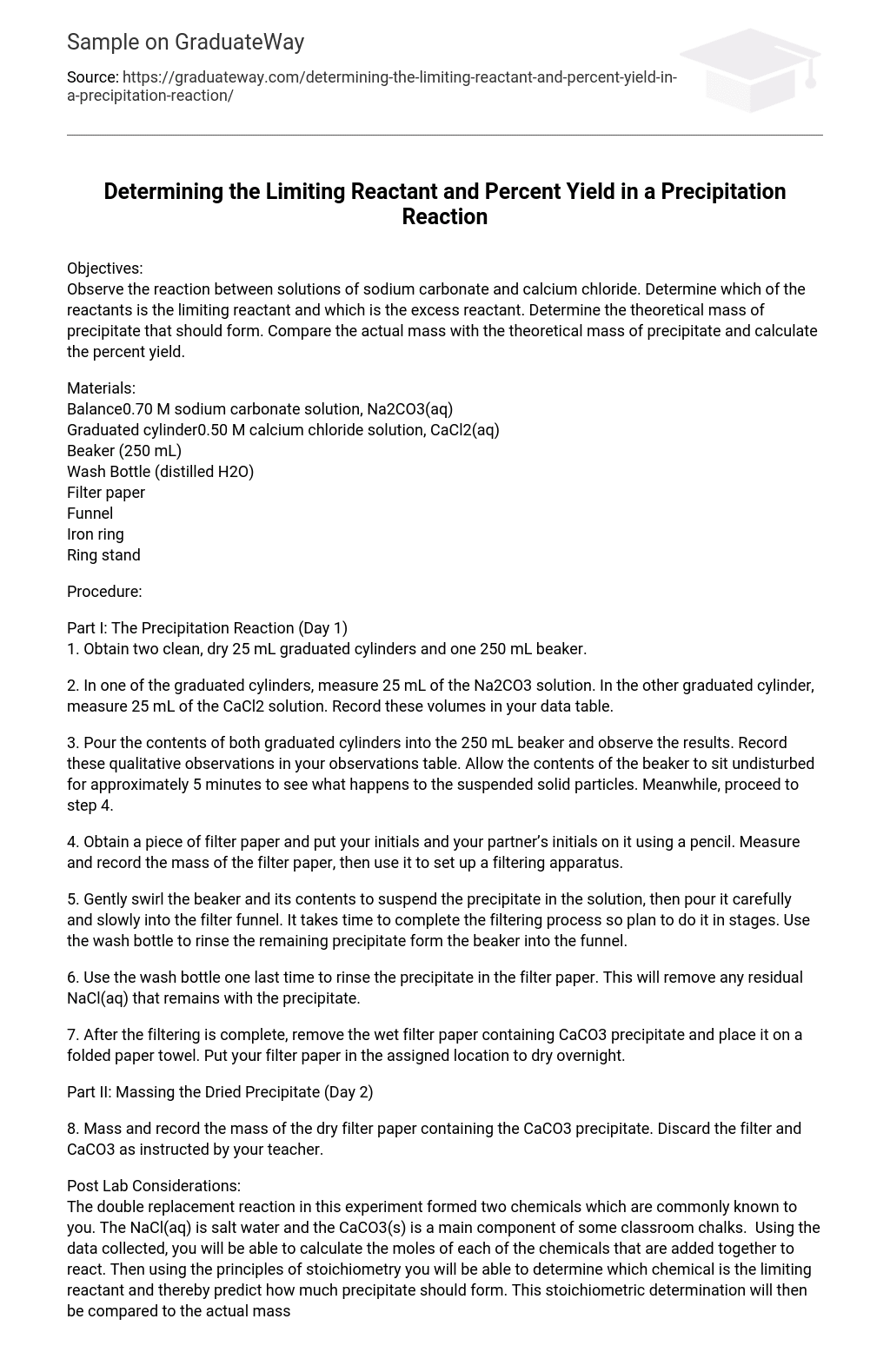Objectives:
Observe the reaction between solutions of sodium carbonate and calcium chloride. Determine which of the reactants is the limiting reactant and which is the excess reactant. Determine the theoretical mass of precipitate that should form. Compare the actual mass with the theoretical mass of precipitate and calculate the percent yield.
Materials:
Balance0.70 M sodium carbonate solution, Na2CO3(aq)
Graduated cylinder0.50 M calcium chloride solution, CaCl2(aq)
Beaker (250 mL)
Wash Bottle (distilled H2O)
Filter paper
Funnel
Iron ring
Ring stand
Procedure:
Part I: The Precipitation Reaction (Day 1)
1. Obtain two clean, dry 25 mL graduated cylinders and one 250 mL beaker.
2. In one of the graduated cylinders, measure 25 mL of the Na2CO3 solution. In the other graduated cylinder, measure 25 mL of the CaCl2 solution. Record these volumes in your data table.
3. Pour the contents of both graduated cylinders into the 250 mL beaker and observe the results. Record these qualitative observations in your observations table. Allow the contents of the beaker to sit undisturbed for approximately 5 minutes to see what happens to the suspended solid particles. Meanwhile, proceed to step 4.
4. Obtain a piece of filter paper and put your initials and your partner’s initials on it using a pencil. Measure and record the mass of the filter paper, then use it to set up a filtering apparatus.
5. Gently swirl the beaker and its contents to suspend the precipitate in the solution, then pour it carefully and slowly into the filter funnel. It takes time to complete the filtering process so plan to do it in stages. Use the wash bottle to rinse the remaining precipitate form the beaker into the funnel.
6. Use the wash bottle one last time to rinse the precipitate in the filter paper. This will remove any residual NaCl(aq) that remains with the precipitate.
7. After the filtering is complete, remove the wet filter paper containing CaCO3 precipitate and place it on a folded paper towel. Put your filter paper in the assigned location to dry overnight.
Part II: Massing the Dried Precipitate (Day 2)
8. Mass and record the mass of the dry filter paper containing the CaCO3 precipitate. Discard the filter and CaCO3 as instructed by your teacher.
Post Lab Considerations:
The double replacement reaction in this experiment formed two chemicals which are commonly known to you. The NaCl(aq) is salt water and the CaCO3(s) is a main component of some classroom chalks. Using the data collected, you will be able to calculate the moles of each of the chemicals that are added together to react. Then using the principles of stoichiometry you will be able to determine which chemical is the limiting reactant and thereby predict how much precipitate should form. This stoichiometric determination will then be compared to the actual mass of CaCO3(s) formed.
Chemists are often concerned with optimal yields in manufacturing a certain chemical. One way of measuring this is to calculate the percent yield of that particular chemical by using this formula:
Percent yield = actual mass produced (grams) x 100
theoretical mass produced (grams)
Data Table:
Your lab report should include a complete data table that includes all measurements and values. Don’t forget labels!! Your lab report should also include a complete observations table.
Chemical Equations:
Write a balanced equation for the reaction that takes place in this lab. Include all subscripts and states of matter.
Calculations:
1. From your Part I results, calculate the moles and mass of Na2CO3 that were added to the beaker.
2. From your Part I results, calculate the moles and mass of CaCl2 that were added to the beaker.
3. Use your answer from Calculations 1-2 above and stoichiometric principles to determine which chemical was the limiting reactant.
4. Use stoichiometric calculations to determine the theoretical mass of CaCO3 precipitate that should have formed.
5. From your Part II results, calculate the actual mass of CaCO3(s) precipitate that formed.
6. Calculate the percent yield of CaCO3(s).
Questions:
1. If you were to evaporate the filtered solution to dryness, would you be left with only solid NaCl? Explain.
2. What theoretical volume of Na2CO3 solution used in this experiment would result in no excess reactant?
3. A precipitation reaction occurs when 50.0 mL of 0.50 M BaCl2(aq) is mixed with 75.0 mL of 0.75 M Na2CO3(aq). The only precipitate is the BaCO3(s) formed.
a. Write a balanced equation that describes this reaction.
b. Which chemical is the limiting reactant? (Show all calculations!) c. Predict the theoretical mass of BaCO3(s) that should form. (Show all calculations!) d. This experiment was conducted and the percent yield was found to be 83%. What was the actual mass of BaCO3(s) that was recovered? (Show all calculations!)





